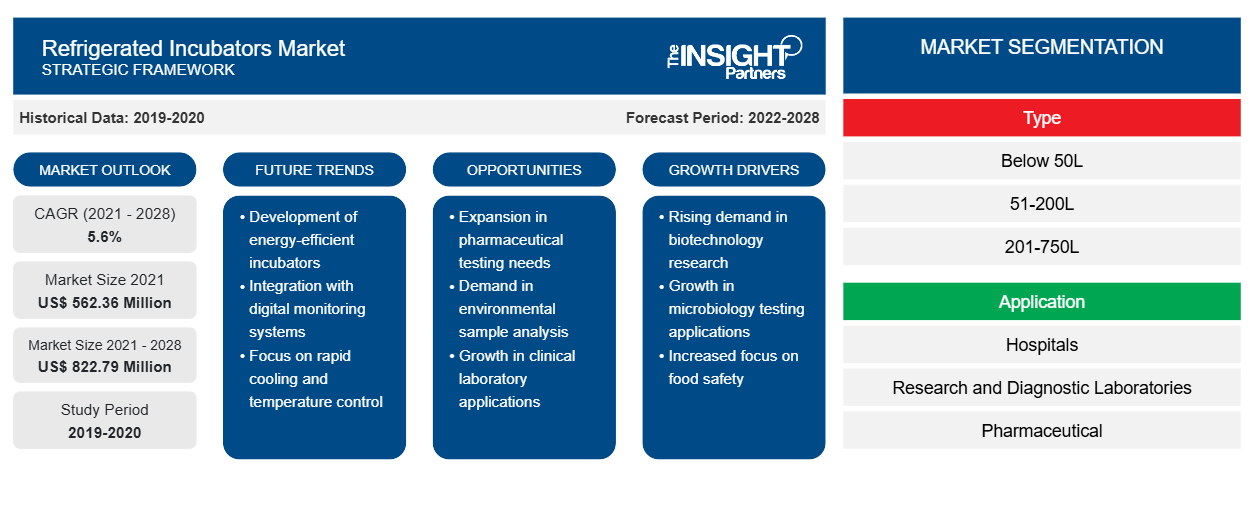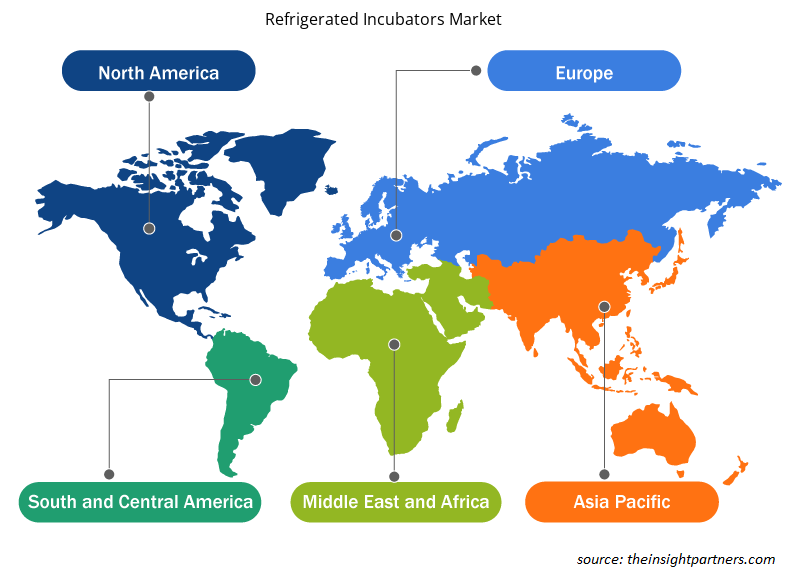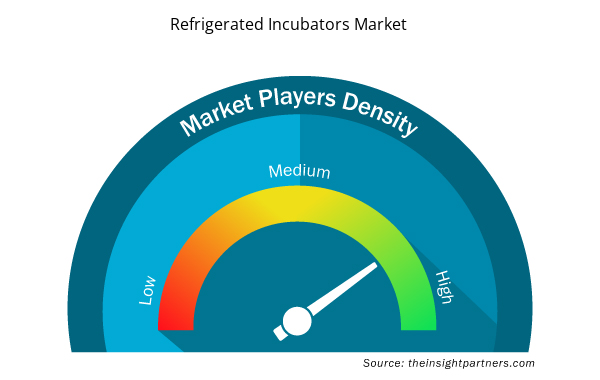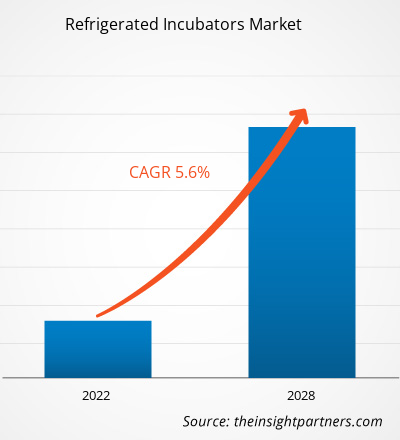The refrigerated incubators market is projected to reach US$ 822.79 million by 2028 from US$ 562.36 million in 2021; it is expected to grow at a CAGR of 5.6% from 2021 to 2028.
High adoption of refrigerated incubators by the research centers or laboratories drives the market growth. In the medical sector, working with microorganisms plays a critical role. Efficiently producing and multiplying microorganisms require a stable incubation phase. With the advent of technology, researchers have shifted toward the utility of advanced technology-based incubators or equipment aiming at energy-efficient consumption compared to traditional cooling incubators. For example, the use of cooling incubators at research centers, pharmaceutical and biotechnology centers, and laboratories is high as it reduces energy consumption and minimizes uneven temperature distribution. Also, several top competitive players, such as Binder GmBH, design refrigerated incubators with unique features, such as a compression-refrigeration unit, ensuring a constant temperature flow. Also, the refrigerated incubators work with a particular conventional technology providing a stable and continuous temperature inside the incubator chamber.Further, with the high advancements and growth in the field of biology through the influx of pharmaceuticals, zoology, microbiology, genetics, and ecology, the requirement for advanced technology-based refrigerated incubators is all-time high. Top competitive players, such as Being Scientific Inc., offer advanced technology-based refrigerated incubators to facilitate the growth and storage of biological specimens. Also, the company's product offerings have high shift or focus towards designing of advanced technology-based refrigerated incubators comprising critical applications. These include Biological Oxygen Demand (BOD), effective for wastewater testing having high applicability in microbiology labs, cell biology labs, and pharmaceutical labs proving effective for the storage of drugs and biological specimens. Therefore, rising R&D activities and top players contributing to innovative product launches related to refrigerated incubators result in high acceptance worldwide. Such activities further propel sales across the global refrigerated incubators market
Customize This Report To Suit Your Requirement
You will get customization on any report - free of charge - including parts of this report, or country-level analysis, Excel Data pack, as well as avail great offers and discounts for start-ups & universities
Refrigerated Incubators Market: Strategic Insights

- Get Top Key Market Trends of this report.This FREE sample will include data analysis, ranging from market trends to estimates and forecasts.
You will get customization on any report - free of charge - including parts of this report, or country-level analysis, Excel Data pack, as well as avail great offers and discounts for start-ups & universities
Refrigerated Incubators Market: Strategic Insights

- Get Top Key Market Trends of this report.This FREE sample will include data analysis, ranging from market trends to estimates and forecasts.
The rising adoption of refrigerated incubators and increasing government funding targeting R&D activities would offer lucrative opportunities for the global refrigerated incubators market during the forecast period. The Public Library of Science (PLOS) report states that in the past few years, numerous challenges have been witnessed related to tackling emerging infectious diseases, particularly anti-microbial resistance (AMR), and neglected diseases (NDs). For example, the Consultative Expert Working Group (CEWG) focuses on R&D financing, and coordination at the World Health Organization (WHO) suggested searching for alternatives related to funding and incentivizing R&D for both innovation and access to emerging infectious diseases. For records, CEWG and Lancet Commission announced global healthcare funding of US$6 billion annually for Anti-microbial Resistance (AMR) and US$10 billion for emerging infections. Therefore, with rising R&D activities targeting emerging infectious diseases and AMR, the adoption of refrigerated incubators has drastically increased over the years.
Currently, manufacturers are channeling funds for research and development activities to introduce cost-effective and sophisticated refrigerated incubator-based products worldwide. Top competitive players, such as Thermo Fischer Scientific, announced the launching of new refrigerated incubators in regional markets, such as Europe, Asia Pacific, and Latin America. The systems are capable of wide application in pharmaceutical, life sciences, water treatment, microbiological industry, and BOD testing. Such aforementioned factors would bolster the growth of the global refrigerated incubators market during 2021–2028.
North America is likely to dominate the global refrigerated incubators market during 2021–2028. The US holds the largest market share in this region. According to the Clinical Trials.gov report, the New York Stem Cell Foundation (NYSCF) conducts research for studying different conditions and diseases by utilizing stem cells and other types of cells, conducting research on biological specimens/samples, performing genetic testing, and storing these samples for short duration intended for future use. Additionally, researchers at the US laboratories are creating pancreatin insulin-producing cells to identify Type 1 diabetes, brain cells, and Parkinson's disease. Such factors highly support the adoption of refrigerated incubators in the US laboratories. Further, in the US alone, there are more than 40,000 individual research laboratories located on university campuses involved in advancing the field of biological and biomedical sciences. The research comprises extensive biological samples from clinical and field studies, representing enormous scientific and financial value for the researchers and organizations, such as biotech/pharma companies, biobanks, research institutes, and universities. Such aforementioned factors are expected to propel the global refrigerated incubators market growth during the forecast period.
Application Insights
Based on application, the global refrigerated incubators market is segmented into hospitals, research and diagnostic laboratories; pharmaceutical, cosmeceutical, and biotechnology companies; research and academic institutes; and others. The hospitals, research and diagnostic laboratories segment is estimated to account for the largest market share during 2021–2028. Hospitals play a significant role in offering an extensive range of medical services to the patients suffering from various diseases. Therefore, the increasing adoption of refrigerated incubators in hospitals is high owing to the rising prevalence of chronic infections and better treating complex disorders. Moreover, in research & diagnostic laboratories, there is significant adoption of such incubators as storing samples requires different types of refrigerated incubators. Thus, aforementioned factors would drive the global refrigerated incubators market growth for this segment during 2021–2028.
Companies operating in the global refrigerated incubators market adopt the product innovation strategy to meet the evolving customer demands worldwide, which also permits them to maintain their brand name in the global market.
Refrigerated Incubators Market Regional Insights
The regional trends and factors influencing the Refrigerated Incubators Market throughout the forecast period have been thoroughly explained by the analysts at Insight Partners. This section also discusses Refrigerated Incubators Market segments and geography across North America, Europe, Asia Pacific, Middle East and Africa, and South and Central America.

- Get the Regional Specific Data for Refrigerated Incubators Market
Refrigerated Incubators Market Report Scope
| Report Attribute | Details |
|---|---|
| Market size in 2021 | US$ 562.36 Million |
| Market Size by 2028 | US$ 822.79 Million |
| Global CAGR (2021 - 2028) | 5.6% |
| Historical Data | 2019-2020 |
| Forecast period | 2022-2028 |
| Segments Covered |
By Type
|
| Regions and Countries Covered | North America
|
| Market leaders and key company profiles |
Refrigerated Incubators Market Players Density: Understanding Its Impact on Business Dynamics
The Refrigerated Incubators Market is growing rapidly, driven by increasing end-user demand due to factors such as evolving consumer preferences, technological advancements, and greater awareness of the product's benefits. As demand rises, businesses are expanding their offerings, innovating to meet consumer needs, and capitalizing on emerging trends, which further fuels market growth.
Market players density refers to the distribution of firms or companies operating within a particular market or industry. It indicates how many competitors (market players) are present in a given market space relative to its size or total market value.
Major Companies operating in the Refrigerated Incubators Market are:
- Binder GmbH
- Thermo Fischer Scientific Inc.
- PHC Holding Corporation
- Eppendorf AG
- Amerex Instruments, Inc.
Disclaimer: The companies listed above are not ranked in any particular order.

- Get the Refrigerated Incubators Market top key players overview
Global Refrigerated Incubators Market – Segmentation
Based on type, the global refrigerated incubators market is segmented into below 50L, 51–200L, 201–750L,751–1500L, and above 1501L. By application, the market is segmented into hospitals, research and diagnostic laboratories; pharmaceutical, cosmeceutical, and biotechnology companies; research and academic institutes; and others. Based on geography, the global refrigerated incubators market is primarily segmented into North America, Europe, Asia Pacific, Middle East and Africa (MEA), and South and Central America. The market in North America is further segmented into the US, Canada, and Mexico. The European refrigerated incubators market is subsegmented into France, Germany, the UK, Spain, Italy, and the Rest of Europe. The market in Asia Pacific is subsegmented into China, India, Japan, Australia, South Korea, and the Rest of APAC. The refrigerated incubators market in the MEA is further segmented into Saudi Arabia, the UAE, South Africa, and the Rest of MEA. The market in South and Central America is subsegmented into Brazil, Argentina, and the Rest of South and Central America.
Company Profiles
- Binder GmbH
- Thermo Fischer Scientific Inc.
- PHC Holding Corporation
- Eppendorf AG
- Amerex Instruments, Inc.
- Sheldon Manufacturing, Inc.
- LEEC Ltd.
- Memmert GmbH+ Co. KG
- Benchmark Scientific
- Gilson Inc.
- Historical Analysis (2 Years), Base Year, Forecast (7 Years) with CAGR
- PEST and SWOT Analysis
- Market Size Value / Volume - Global, Regional, Country
- Industry and Competitive Landscape
- Excel Dataset


- Nurse Call Systems Market
- Underwater Connector Market
- Photo Printing Market
- Excimer & Femtosecond Ophthalmic Lasers Market
- Enteral Nutrition Market
- Arterial Blood Gas Kits Market
- Online Exam Proctoring Market
- Dry Eye Products Market
- Water Pipeline Leak Detection System Market
- Trade Promotion Management Software Market

Report Coverage
Revenue forecast, Company Analysis, Industry landscape, Growth factors, and Trends

Segment Covered
Type, and Application

Regional Scope
North America, Europe, Asia Pacific, Middle East & Africa, South & Central America

Country Scope
Argentina, Australia, Brazil, Canada, China, France, Germany, India, Italy, Japan, Mexico, Saudi Arabia, South Africa, South Korea, Spain, United Arab Emirates, United Kingdom, United States
Frequently Asked Questions
What is the COVID 19 impact on the refrigerated incubators market in the coming years?
With COVID-19 continuing to spread all over the world, researchers are looking into numerous options for possible treatment, including existing options. Several measures are being taken to treat the disease and prevent transmission. With many laboratory and research services under acute pressure, the market for refrigerated incubators market is expected to grow at a steady rate. The governments of various countries along with the EU have significantly increased the funding towards life science and biotechnology sectors to increase the region’s research and innovation capabilities. Therefore, while the initial phase of the pandemic led to a steep decline in the demand for refrigerated incubators, as the pandemic improved, the demand for refrigerated incubators saw a steady increase. To cater to high demand many players have ramped up their production. For instance, companies such as Thermo Fisher Scientific, F. Hoffmann-La Roche AG, EverlyWell, and Abbott were producing COVID-19 tests. Abbott had received Emergency Use Authorization (EUA) for a point-of-care test that can provide results in minutes. Thus, increased production by the companies has resulted in profits, and the outbreak of COVID-19 has shown a positive impact on refrigerated incubators market growth.
Which are the top companies that hold the market share in refrigerated incubators market?
Thermo Fisher Scientific Inc. and PHC Holdings Corporation are the top two companies that hold huge market shares in the refrigerated incubators market.
Which region is expected to witness significant demand for refrigerated incubators market in the coming years?
Global refrigerated incubators market is segmented by region into North America, Europe, Asia Pacific, Middle East & Africa, and South & Central America. In North America, the U.S. is the largest market for refrigerated incubators. The region is expected to witness a consistent growth owing to rise in awareness and usage of refrigerated incubators, increasing adoption of technological advancements, growing investment by the public and private sectors in refrigerated incubators are projected to accelerate the growth of the refrigerated incubators market. Furthermore, the Asia Pacific region is expected to account for the fastest growth in the refrigerated incubators market. In China, Japan, and India, the market is expected to grow rapidly owing to factors such as the research activities & pharmaceutical manufacturing and increasing investments by leading players and respective government agencies in emerging APAC countries.
What is the market CAGR value of refrigerated incubators market during forecast period?
The CAGR value of the refrigerated incubators market during the forecasted period of 2021-2028 is 5.6%.
Which type held the largest share in the refrigerated incubators market?
The 51-200L segment dominated the global refrigerated incubators market and accounted for the largest market share of 41.47% in 2021.
Which application held the largest share in the refrigerated incubators market?
The hospital, research & diagnostic laboratories segment dominated the global refrigerated incubators market and held the largest market share of 55.05% in 2021.
Who are the key players in the refrigerated incubators market?
The refrigerated incubators market majorly consists of the players such Binder GmbH, Thermo Fisher Scientific Inc., PHC Holdings Corporation, Eppendorf AG, Amerex Instruments, Inc., Sheldon Manufacturing, Inc., LEEC Ltd., Memmert Gmbh + Co. Kg, Benchmark Scientific, and Gilson Inc. among others.
What is refrigerated incubators?
Refrigerated incubators are designed to provide a constant cold temperature environment to either promote or prevent the growth of cells, tissue cultures, and other biological samples. These refrigerated incubators are ideal for various applications, including BOD determinations, plant and insect studies, fermentation studies, bacterial cultures, water pollution testing, and enzyme digestion studies. These refrigerated incubators feature a heavy-duty cooling system to optimize airflow and temperature uniformity, programmable controls with audible and visual alarms, a well-insulated cabinet, and precise temperature control and uniformity. The refrigerated incubator works with a unique circulating air technology that ensures a stable, constant climate in the interior. The compressor enables temperature ranges from -5 to 100°C so that in addition to maintaining the optimum incubation temperature for the proliferation of microorganisms, an occasional cooling cycle or hot air disinfection cycle is also possible.
What are the driving factors for the refrigerated incubators market across the globe?
Key factors such as rising adoption of refrigerated incubators for research activities that are targeting infectious diseases and the growing technological advancements in refrigerated incubators are expected to boost the market growth for the refrigerated incubators over the years.
Trends and growth analysis reports related to Life Sciences : READ MORE..
The List of Companies - Refrigerated Incubators Market
- Binder GmbH
- Thermo Fischer Scientific Inc.
- PHC Holding Corporation
- Eppendorf AG
- Amerex Instruments, Inc.
- Sheldon Manufacturing, Inc.
- LEEC Ltd.
- Memmert GmbH+ Co. KG
- Benchmark Scientific
- Gilson Inc.

 Get Free Sample For
Get Free Sample For